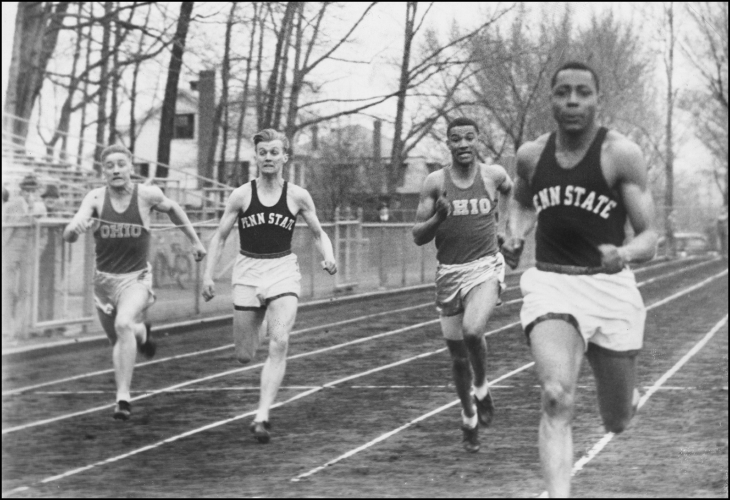In an athletic career that lasted more than a decade, Norwood H. “Barney” Ewell thrilled track spectators from State College to London’s Wembley Stadium, where he won three medals at the 1948 Olympics.
Ewell won numerous titles in the sprints and long jump while representing Penn State, where he arrived in the fall of 1939. Had World War II not scuttled the 1940 and 1944 Olympics, many contend that he would have perhaps become an American hero to rival Jesse Owens. His three Olympic medals are the most by a Penn State alumnus.
Born on February 28, 1918, in Lancaster, Pennsylvania, Ewell shined as a high school star before enrolling at Penn State. One of about thirty African Americans within a student body of 3,000 Ewell became a symbol of both racial inclusion and controversy.

At Penn State he attended classes, studied, and practiced with White students, epitomizing the institution’s history of racial inclusion. The dormitories remained all-white, however, so Ewell lived in Lincoln Hall, the off-campus boarding house for Black male students. Ewell also had to leave town for haircuts since State College’s barbershops did not welcome Black customers.
In May 1940, Ewell became embroiled in an intercollegiate battle over his skin color. In a contest scheduled at the U.S. Naval Academy, administrators in Annapolis refused to allow Ewell and a Black teammate to compete. Penn State administrators rejected Navy’s stipulations, instead offering to move the meet to State College.
Ewell dominated the relocated meet, leading the Nittany Lions to victory over the previously undefeated Midshipmen. The press predicted Ewell would shine at the upcoming Tokyo Olympics, possibly repeat Jesse Owens’s quadruple-gold medal performance in Berlin four years earlier.
That opportunity never arrived. After the cancellation of the 1940 games, Ewell put his Penn State career on hold and joined the U.S. Army. He spent the summers of 1940 and 1944 serving his country in a different kind of uniform.
After the war, Ewell returned to Penn State to continue studying and sprinting. At the 1948 U.S. Olympic Trials, the 30-year old Ewell defied his age and younger competitors by equaling the 100-meter world record. At the London Olympics he earned a gold medal in the 4×100-meter relay and silver medals in the 100-meter and 200-meter dashes, finishing an agonizing hundredth of a second behind first place in both events.
At Penn State, Ewell’s career inspired action on racial equity, leading students, faculty, and administrators to fight segregation in intercollegiate sports. In 1948, a few months after Ewell collected three Olympic medals, Penn State became the first team to field Black football players in the Cotton Bowl Classic. (The game against Southern Methodist University, played in Dallas, Texas, ended in a 13-13 tie.)
Inspired by Ewell and the Black members of the football team who assaulted the college’s athletic color lines, Penn State students launched a boycott against State College barbershops that refused to cut the hair of black patrons.
Ewell’s athletic prowess and contributions to civil rights inspired muralist Henry Varnum Poor to use Ewell as his model for the track athlete in the Land-Grant Frescoes in Old Main. Poor explained that Ewell’s visage honored “not only the outstanding Negro athletes of Penn State, but Penn State’s own free and democratic spirit.” Ewell died in 1996 at the age of 78.
Cam Mallet & Mark Dryerson
Sources:
Norwood “Barney” Ewell Biographical File, Athlete Files, Athletic Department Records, University Archives, Eberly Family Special Collections Library, Pennsylvania State University.
Durso, Joseph. “Barney Ewell, 78, Top Sprinter; Won Gold in Postwar Olympics,” New York Times, April 5, 1996.
Martin, Charles H. Benching Jim Crow: The Rise and Fall of the Color Line in Southern College Sports, 1890-1980. Urbana: University of Illinois Press, 2010.
Prato, Lou. Penn State Football Vault: The History of the Nittany Lions. Atlanta: Whitman, 2008.
First Published: June 11, 2021
Last Modified: February 17, 2025
